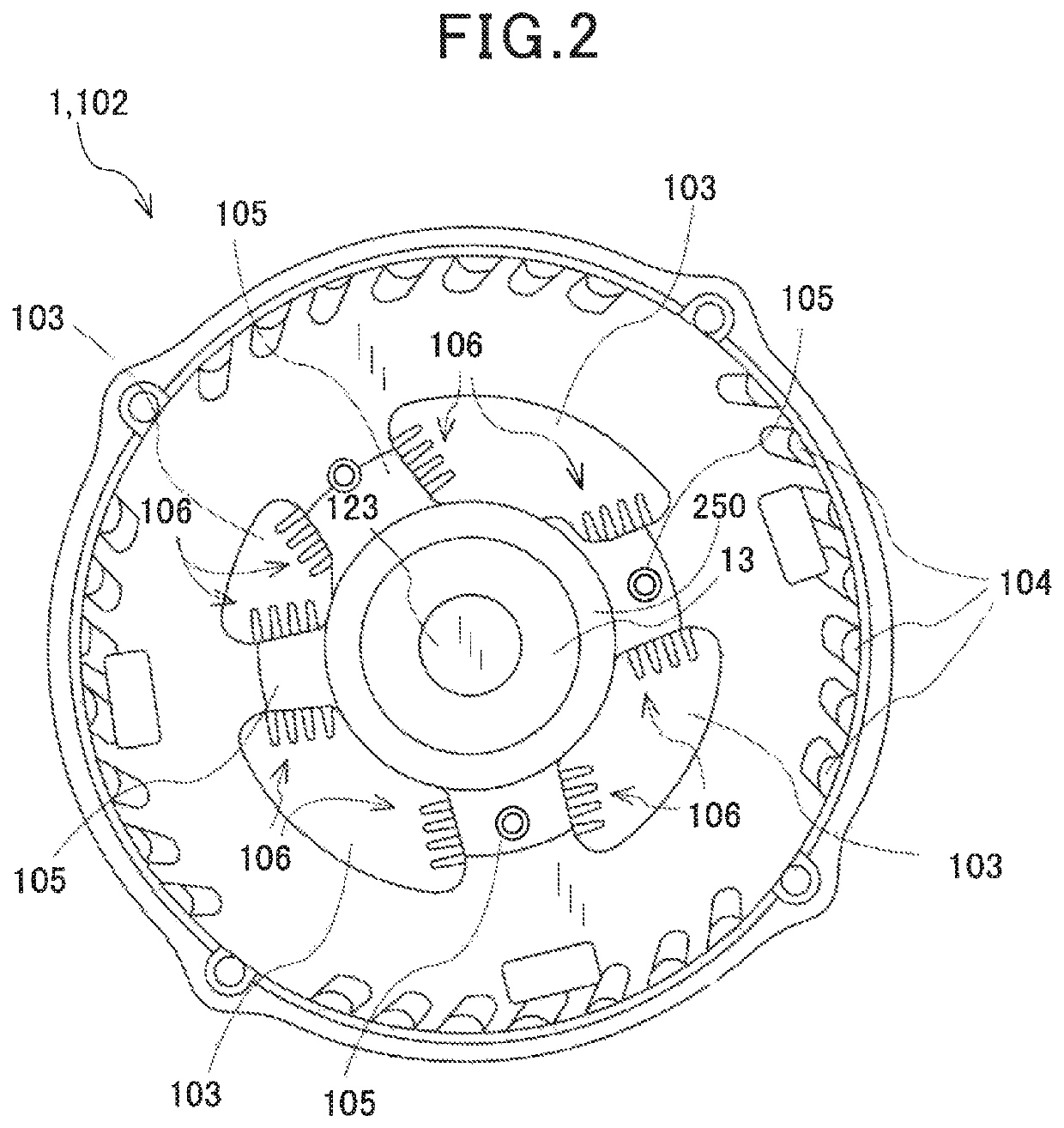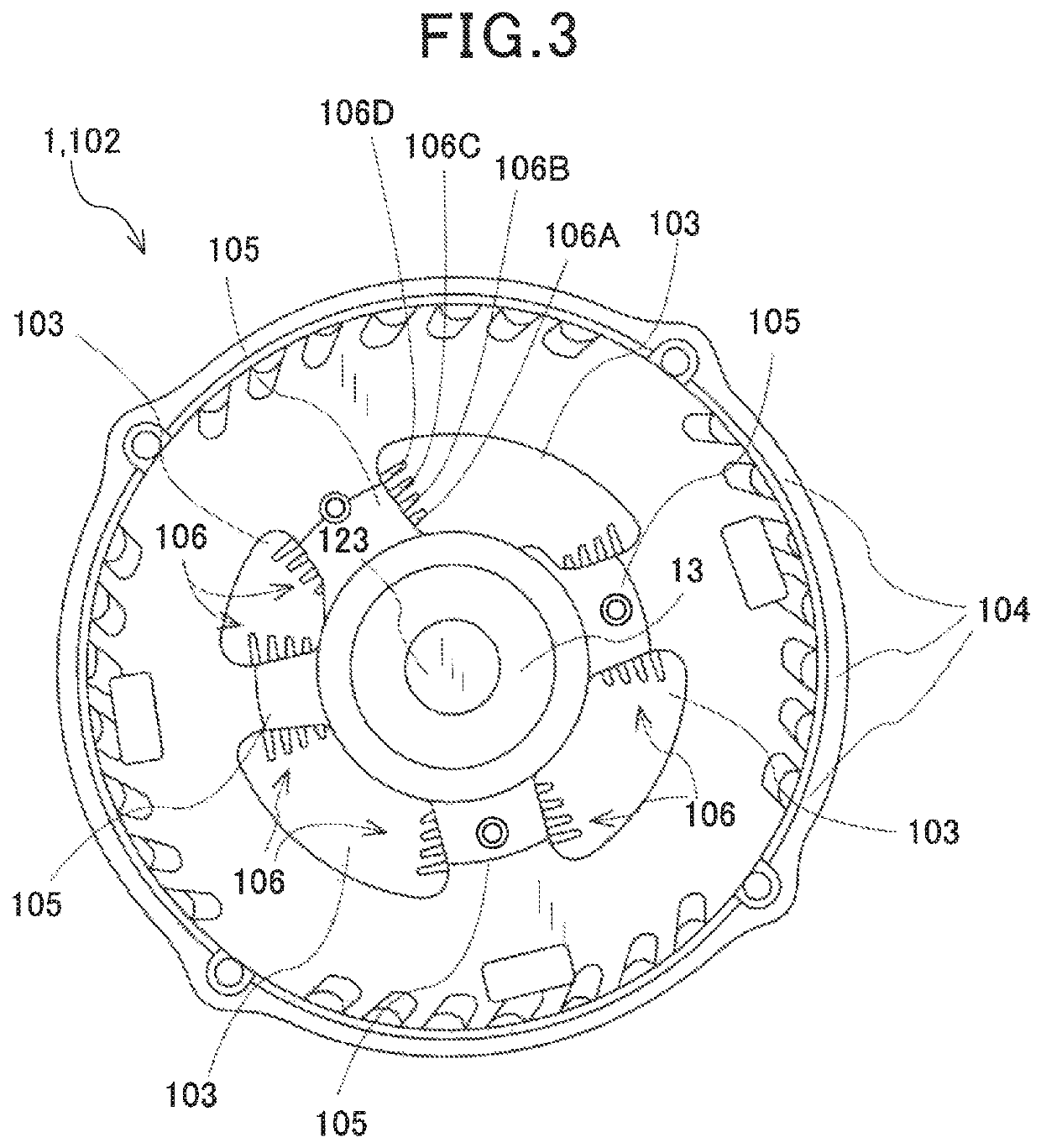Rotating electrical machine
a technology of electrical machines and rotating shafts, which is applied in the direction of dynamo-electric machines, electrical apparatus, supports/encloses/casings, etc., can solve the problems of increasing mechanical noise caused by the rotation of cooling fans, and increasing the amount of heat generated by rotating electrical machines. to achieve the effect of reducing the transmission of heat and discharging the spokes
- Summary
- Abstract
- Description
- Claims
- Application Information
AI Technical Summary
Benefits of technology
Problems solved by technology
Method used
Image
Examples
first embodiment
[0023]FIGS. 1 and 2 illustrate the electrical rotating machine 1 with a built-in controller according to the first embodiment. FIG. 1 is a cross section of the electrical rotating machine 1.
[0024]The electrical rotating machine 1 is mounted in an automotive vehicle and supplied with electric power from a battery to work as an electric motor which produces a drive force to move the vehicle. The electric rotating machine 1 is also supplied with a drive force (i.e., torque) generated by an engine mounted in the vehicle to work as an electrical generator to produce electric power to charge the battery. The electrical rotating machine 1 is equipped with the controller 2.
[0025]The electrical rotating machine 1 is also equipped with the housing 10, the stator 11, the rotor 12, the cooling fans 14, the slip rings 15, and the brushes 16.
[0026]The housing 10 has disposed therein the stator 11 and the rotor 12 which face each other and serves as a support which retains the rotor 12 (i.e., the ...
second embodiment
[0058]The electrical rotating machine 1 of the second embodiment is different only in structure of the heat sinks 106 from the one in the first embodiment. Other arrangements are identical, and explanation thereof in detail will be omitted here. FIG. 3 is a side view which illustrates the heat sinks 106 of the electrical rotating machine 1 in the second embodiment.
[0059]Each of the heat sinks 106 has the fins 106A, 106B, 106C, and 106D which are, as can be seen in FIG. 3, different from each other in height thereof, i.e., a distance between the tip of each of the fins 106A to 106c and the outer periphery of the spoke 105, in other words, a distance by which each of the fins 106A to 106D extend from the spoke 105. In this embodiment, the height increases stepwisely from the fin 106A which is located innermost in the radial direction of the housing 10 to the fin 106D which is located outermost side in the radial direction of the housing 10.
Beneficial Advantages of the Second Embodimen...
third embodiment
[0063]The electrical rotating machine 1 of the third embodiment is different only in structure of the heat sinks 106 from the one in the first embodiment. Other arrangements are identical, and explanation thereof in detail will be omitted here. FIG. 4 is a side view which illustrates the heat sinks 106 of the electrical rotating machine 1 in the third embodiment. FIG. 5 is a sectional view, as taken along the line V-V in FIG. 4.
[0064]Each of the heat sinks 106 is, as can be seen in FIGS. 4 and 5, disposed on a portion of a periphery of a corresponding one of the spokes 105 which does not directly face the air inlet 103. In other words, the fins 106A to 106D of each of the heat sinks 106 extend substantially parallel to each other from the spoke 105 in the axial direction of the housing 10 (i.e., the rotor 12 or the rotating shaft 123). The fins 106A to 106D are equal in projecting height to each other.
Beneficial Advantages of the Third Embodiment
[0065]The structure of the electrical...
PUM
 Login to View More
Login to View More Abstract
Description
Claims
Application Information
 Login to View More
Login to View More - R&D
- Intellectual Property
- Life Sciences
- Materials
- Tech Scout
- Unparalleled Data Quality
- Higher Quality Content
- 60% Fewer Hallucinations
Browse by: Latest US Patents, China's latest patents, Technical Efficacy Thesaurus, Application Domain, Technology Topic, Popular Technical Reports.
© 2025 PatSnap. All rights reserved.Legal|Privacy policy|Modern Slavery Act Transparency Statement|Sitemap|About US| Contact US: help@patsnap.com



